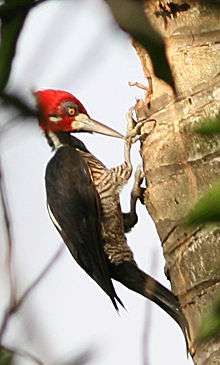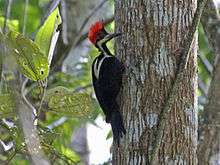Crimson-crested woodpecker
| Crimson-crested woodpecker | |
|---|---|
 | |
| Male | |
| Scientific classification | |
| Kingdom: | Animalia |
| Phylum: | Chordata |
| Class: | Aves |
| Order: | Piciformes |
| Family: | Picidae |
| Genus: | Campephilus |
| Species: | C. melanoleucos |
| Binomial name | |
| Campephilus melanoleucos (Gmelin, 1788) | |
The crimson-crested woodpecker (Campephilus melanoleucos) is a very large woodpecker which is a resident breeding bird from Panama south to northern border regions of Argentina, and on Trinidad.

The habitat of this species is forests and more open woodland. A nesting hole is excavated in large dead trees. The entrance is fairly large, about 45 to 50 cm (17.5 to 19.5 in) in diameter, and oval-shaped. Female lays 2 to 3 white eggs, sometimes four. Incubation lasts about 9 to 14 days, by both sexes. Woodpeckers have short incubation period, but at contrary, nesting period is longer than in other birds’ species. Chicks are brooded and fed by both parents, and remain at nest for 3 to 4 weeks after hatching. Young remain within the family group until next breeding season.
The crimson-crested woodpecker is 33–38 cm (13–15 in) long and weighs 180–285 g (6.3–10.1 oz). It is one of the largest woodpeckers in its range, though the higher elevation powerful woodpecker is roughly the same size.
It is all black above, has a red crest and has white lines running down the sides of the black throat and shoulders, which meet in a V on the back. The underparts are white, heavily barred with black. They show white on the wings in flight. Adult males have a red line from the bill to the throat and red on the front of the crown. In adult females, these plumage features are black.
The crimson-crested woodpecker somewhat resembles the pileated woodpecker of North America, but may be confused in its own range with the lineated woodpecker. The lineated woodpecker is the only bird of similar plumage and size. In that species, the white face line is narrower, and the white shoulder lines do not meet on the back.
Crimson-crested woodpeckers chip out holes, often quite large, while searching out insects in trees. They mainly eat wood-boring insects and larvae, as well as ants, termites, small vertebrates and caterpillars. The animal matter is sometimes supplemented with berries. Several of these large woodpeckers may be seen (4 or more) attracted to the same dead tree while feeding.
The call of this widespread but wary bird is a loud, ringing CHEE-sic. Both sexes drum.
References
- ↑ BirdLife International (2012). "Campephilus melanoleucos". IUCN Red List of Threatened Species. Version 2013.2. International Union for Conservation of Nature. Retrieved 26 November 2013.
- ffrench, Richard (1991). A Guide to the Birds of Trinidad and Tobago (2nd ed.). Comstock Publishing. ISBN 0-8014-9792-2.
- Hilty, Steven L (2003). Birds of Venezuela. London: Christopher Helm. ISBN 0-7136-6418-5.
External links
- on Oiseaux Birds
- Crimson-crested Woodpecker videos, photos & sounds on the Internet Bird Collection
- Stamps (for Suriname) with RangeMap
- Crimson-crested Woodpecker photo gallery VIREO
